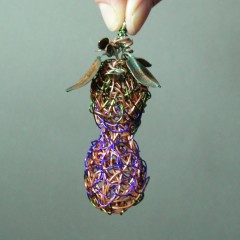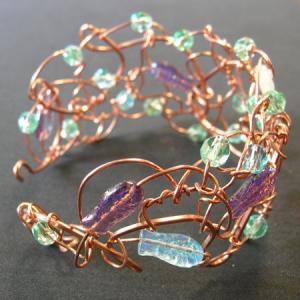YOJ11-03 The Peanut Experiment
The Peanut Experiment (2011)
Copper, polymer-coated copper, sterling silver
Formed, fold-formed, cold-joined, fused, patinated
W 2.5 cm x H 8.5 cm
.
This week’s entry is actually the end of a several week long process where I experimented with a different method for forming.
This is an idea I’ve been wanting to try ever since seeing a website by a British artist who made life size human figures out of wire. His name is regretfully forgotten, and the link to his website lost. What I remember the most – besides the wonderful realism of his figures – was that he built them over a solid core, which was later burned out.
Cores are often used with metal clay for making hollow forms such as boxes or beads. After some research, I bought some cork clay, and then promptly got too busy to go any further.
Cork clay is usually burned out in a kiln. Since I’m not interested in making a substantial investment for something I may not stick with, I started researching low-tech alternatives. I remembered a thread on Ganoksin about using a flower pot kiln for burning out wax. The Ganoksin archives, while vast and wide-ranging, are frustrating to search, and didn’t provide anything really helpful. Evenually, I found some basic information elsewhere online for building a flower pot kiln and went about collecting the materials to build one.
I wasn’t sure if the kiln would get hot enough to burn out the cork clay, so I made my first core out of bread dough. Since it was just an experiment, I opted to do a freeform winding of copper wire around the core.
Finding an unglazed clay pot of an appropriate size in January in Canada is a challenge. However, I did find one – and only one – at Home Depot.
Once back at home, I lined the pot with tin foil, set up the hotplate on my back deck, put a modified coffee can on the element, added the piece to be fired, covered it, and turned it on.
It smoked a lot, and stunk to high heaven, but considering it was in -12°C and blowing gusts, it worked very well! The core-free wire looks a bit like a peanut.
Because with the YOJP, a finished piece is supposed to be submitted each week, I decided to also try my hand at making some leaves with fold forming, which were then patinated using salt & ammonia. They were attached to the peanut and presto! a finished piece.
It’s not pretty, but it wasn’t intended to be. My next step will be to try again with the cork clay.
Process photos:
















 Custom & bespoke designer #diannekargbaron #wearjewelryyoulove #wsstudiotour
Custom & bespoke designer #diannekargbaron #wearjewelryyoulove #wsstudiotour








I don’t think I adequately expressed how exciting your project is on my YOJ post comment. I admire the effort and labor you have put into this.
I think if you manage to arrive at some workable solutions, it can open up a whole new world of creative wire opportunities that are currently blocked.
The peanut itself is cute, but it doesn’t hold a candle to the actual work you are doing:)
I had a thought, it was the peanuts that sparked it. What about using the cornstarch packing peanuts for your form. They sell ones in the kits crafts section as well that you get damp and they stick together. I’m not sure this would be a solid enough surface to work with. Or a paper mache, you could burn out with a torch.
That’s an interesting idea Erica. I’m not sure if they would be solid enough either, but they would certainly burn out very quickly! Thanks for the suggestion!